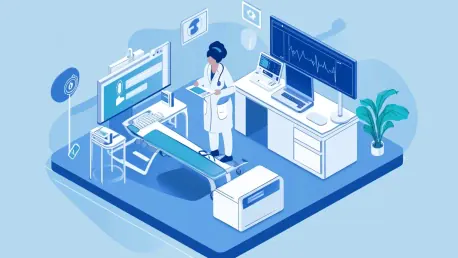The healthcare landscape is rapidly evolving, with hospitals increasingly relying on telemedicine to manage high-acuity patients and improve financial performance. This article explores the strategic role of acute specialty telemedicine in modern hospitals, addressing the growing complexity of inpatient care and the pressing need for hospitals to adapt.
Rising Inpatient Acuity and Chronic Disease Prevalence
The Shift to Outpatient Services
As the healthcare industry continues to evolve, hospitals are transitioning from predominantly inpatient care to developing robust outpatient services. This shift aims to maximize value-based payments, reduce costs, and provide care in the least intensive settings when possible. By focusing on these less intensive settings, hospitals can allocate resources more efficiently and improve patient outcomes through better management of chronic conditions. Moreover, emphasizing outpatient services aligns with the broader industry trend toward preventive care and early intervention, which can reduce the need for more complex and costly inpatient treatments.
This shift has been driven by multiple factors, including advances in medical technology, changes in payer incentives, and the rising costs associated with inpatient care. With value-based payment models becoming more prevalent, hospitals are incentivized to reduce unnecessary admissions and manage patients’ health more proactively. These models prioritize the quality and efficiency of care rather than the volume of services provided, encouraging hospitals to invest in outpatient services and comprehensive care management programs. By optimizing care pathways and leveraging innovative approaches like telemedicine, hospitals can achieve better outcomes for their patients while also improving their financial performance.
Increasing Complexity of Inpatient Care
As the complexity of patients requiring inpatient care grows, hospitals need rapid access to specialized services, such as stroke and psychiatric care. Data from the American Hospital Association highlights a 3 percent increase in inpatient acuity from 2019 to 2024, with further increases anticipated over the next decade. This rise in complexity is primarily driven by the growing prevalence of chronic diseases, which necessitate intricate care and specialized services. With chronic disease rates expected to continue rising, hospitals face significant challenges in managing the diverse and complex needs of their inpatient populations.
By 2050, the number of Americans over age 50 with at least one chronic disease is predicted to nearly double, with a significant increase in those with multiple chronic conditions. This shift in patient demographics places additional strain on hospitals, as they must provide increasingly specialized and coordinated care to manage these complex cases. Hospitals that fail to adapt to this changing landscape will face escalating financial challenges and may struggle to provide high-quality care to their patients. To address these challenges, hospitals must explore innovative solutions like telemedicine that can enhance their capacity to deliver specialized care and improve patient outcomes.
Strategic Solution: Acute Multi-Specialty Telemedicine
Integration of Telemedicine Services
Acute multi-specialty telemedicine emerges as a strategic solution, integrating various specialty services like neurology, psychiatry, cardiology, and infectious disease. This integration allows specialists to be available in real-time, reducing the strain on onsite teams and ensuring that patients receive timely, expert care. Telemedicine’s ability to connect patients with specialists regardless of their location enables hospitals to provide high-quality, coordinated inpatient care without the need for extensive in-house resources. This approach not only enhances the efficiency of care delivery but also improves patient outcomes by ensuring that patients receive the appropriate level of care when they need it most.
The seamless integration of telemedicine services into hospital operations can also lead to significant cost savings. By reducing the need for costly locum coverage and extensive recruitment and retention efforts for multi-specialty physicians, hospitals can allocate resources more effectively. Additionally, telemedicine can help streamline the care process by facilitating collaboration among specialists, enabling more accurate diagnoses and treatment plans. This collaborative approach can lead to better patient outcomes and reduced lengths of stay, ultimately improving the hospital’s financial performance and overall efficiency.
Competitive Edge and Efficiency
By leveraging telemedicine, hospitals can manage complex cases and emergencies more effectively, offering a competitive edge in a rapidly changing healthcare landscape. This setup allows for life-saving interventions and optimizes the management of high-acuity patients, ensuring that hospitals can provide the highest level of care while minimizing the strain on their resources. The ability to access specialized care in real-time allows hospitals to address critical cases promptly, improving patient outcomes and enhancing the overall quality of care.
In addition to improving patient care, telemedicine can also lead to significant operational efficiencies. For example, telemedicine can reduce the need for patient transfers and minimize the time patients spend waiting for specialist consultations. This streamlined approach to care delivery can help hospitals operate more efficiently, reducing costs and improving patient satisfaction. Furthermore, by offering a more efficient and effective model of care, hospitals can differentiate themselves from competitors and attract more patients, ultimately enhancing their market position and financial performance.
Balancing Inpatient Acuity and Length of Stay
Length-of-Stay Optimization
Hospitals must balance catering to an increasingly acute inpatient population while minimizing lengths of stay. Length-of-stay optimization remains a priority, with telemedicine playing a key role in achieving this balance. According to a McKinsey survey, 84 percent of respondents emphasize length-of-stay optimization as a focal area, with 41 percent considering it the performance area with the greatest potential for untapped margin improvement. By leveraging telemedicine, hospitals can streamline the admission, treatment, management, and discharge processes, reducing the time patients spend in the hospital and improving overall efficiency.
Telemedicine also plays a crucial role in mitigating the need to board patients in the emergency department (ED) while awaiting transfer to facilities with the required specialists. This can significantly reduce the burden on the ED and improve patient flow throughout the hospital. By enabling rapid access to specialists, telemedicine helps ensure that patients receive the appropriate level of care promptly, reducing unnecessary delays and improving overall patient outcomes. This approach not only enhances the patient experience but also contributes to the hospital’s financial performance by reducing the costs associated with prolonged hospital stays.
Three Distinct Qualities of Telemedicine
Telemedicine offers three distinct qualities that make it an invaluable tool for hospitals seeking to optimize their operations. First, telemedicine eliminates the wait for a specialist to admit, treat, manage, and discharge a patient. This rapid access to specialized care ensures that patients receive the appropriate level of care in a timely manner, reducing delays and improving overall efficiency. Second, telemedicine mitigates the need to board patients in the emergency department while awaiting transfer to facilities with the required specialists. This can significantly reduce the burden on the ED and improve patient flow throughout the hospital.
Finally, telemedicine brings together multiple specialists for patient care, bypassing the need for costly locum coverage or extensive recruitment and retention efforts for multi-specialty physicians. By enabling remote consultations and collaborative care, telemedicine ensures that patients receive comprehensive, coordinated care without the need for extensive in-house resources. This approach not only enhances the quality of care but also reduces costs and improves operational efficiency. As hospitals continue to face increasing demands and financial pressures, the ability to leverage telemedicine to optimize care delivery and improve patient outcomes will become increasingly important.
Real-World Benefits and Financial Improvements
Case Studies and Examples
Several real-world examples illustrate the benefits of acute specialty telemedicine. One hospital partnered with Access TeleCare and reduced the length-of-stay for behavioral health patients by nearly 12 hours on average. By deploying virtual behavioral health services in its emergency department and virtual Consultation-Liaison Psychiatry in its med-surg units and ICU, the hospital avoided $1.7 million in annualized boarding costs. This example highlights the significant impact that telemedicine can have on hospital operations, reducing costs and improving patient outcomes through more efficient care delivery.
Another hospital decreased its overall length-of-stay by 10 percent through a tele-infectious disease program and observed a 25 percent increase in infectious disease revenue in its first year. This program enabled the hospital to provide timely, expert care to patients with complex infectious disease needs, improving patient outcomes and enhancing the hospital’s financial performance. These case studies demonstrate the transformative potential of telemedicine in modern hospitals, showcasing how innovative approaches to care delivery can lead to significant operational and financial improvements.
Financial and Patient Impact
The significant patient impact of minimizing lengths of stay where medically appropriate is evident in the lives saved and complications avoided. Telemedicine allowed one hospital to reduce a patient’s expected weeks-long stay to several days by accurately diagnosing and optimizing antibiotic treatment through an infectious disease specialist. This outcome not only improved the patient’s experience but also reduced the hospital’s costs and resources associated with a prolonged stay. Another patient avoided an extended course of multiple drugs for suspected tuberculosis when telemedicine facilitated an accurate diagnosis of an autoimmune condition and coordinated care with a local rheumatology specialist.
These examples underscore the importance of telemedicine in improving patient outcomes and enhancing the efficiency of hospital operations. By providing accurate diagnoses and optimizing treatment plans, telemedicine can reduce the length of hospital stays and improve the overall quality of care. This approach not only benefits patients but also contributes to the hospital’s financial performance by reducing costs and increasing revenue from specialized services. As hospitals continue to face increasing demands and financial pressures, the ability to leverage telemedicine to optimize care delivery and improve patient outcomes will become increasingly important.
The Future of Acute Specialty Telemedicine
Growing Value and Demand
As the inpatient population becomes more acute and healthcare systems prioritize length-of-stay optimization, the value of acute specialty telemedicine is expected to rise. Hospitals must seek reliable multi-specialty telemedicine partners to optimize physician availability and coordination effectively. By partnering with telemedicine providers, hospitals can ensure that they have access to the specialized care they need, when they need it, regardless of the clinical scenario’s complexity. This approach not only enhances the quality of care but also improves operational efficiency and financial performance.
The growing demand for telemedicine services is driven by the need for timely, expert care and the increasing complexity of inpatient populations. As hospitals continue to face rising costs and financial pressures, the ability to leverage telemedicine to provide high-quality, coordinated care will become increasingly important. By investing in telemedicine and forming strategic partnerships with trusted providers, hospitals can position themselves to meet the evolving needs of their patients and thrive in the rapidly changing healthcare landscape.
Commitment to Quality and Patient Safety
The healthcare landscape is rapidly evolving, with a growing number of hospitals turning to telemedicine to manage high-acuity patients and enhance their financial outcomes. This trend highlights the strategic importance of acute specialty telemedicine in contemporary healthcare settings. As inpatient care grows increasingly complex, hospitals face the urgent need to adapt to these changes. Acute specialty telemedicine enables better management of critical conditions, providing real-time, remote access to expert medical care. This not only improves patient outcomes but also optimizes resource allocation and reduces the strain on hospital staff. The integration of telemedicine into hospital operations supports the efficient delivery of care, helps manage patient loads, and offers financial advantages by reducing readmission rates and streamlining treatment processes. Furthermore, telemedicine promotes continuous learning and collaboration among healthcare professionals, ensuring that patients receive the most up-to-date and effective treatments available.









